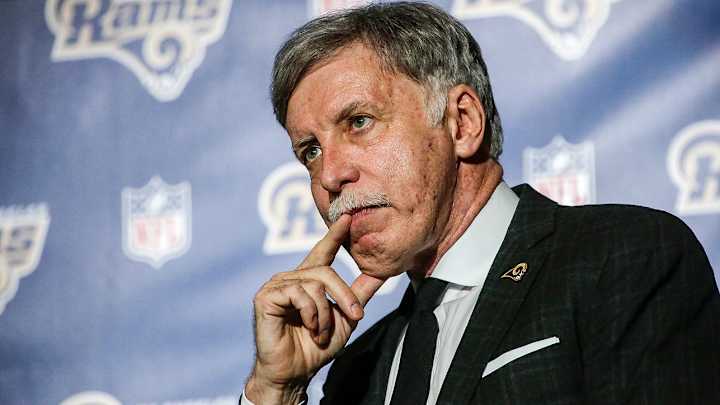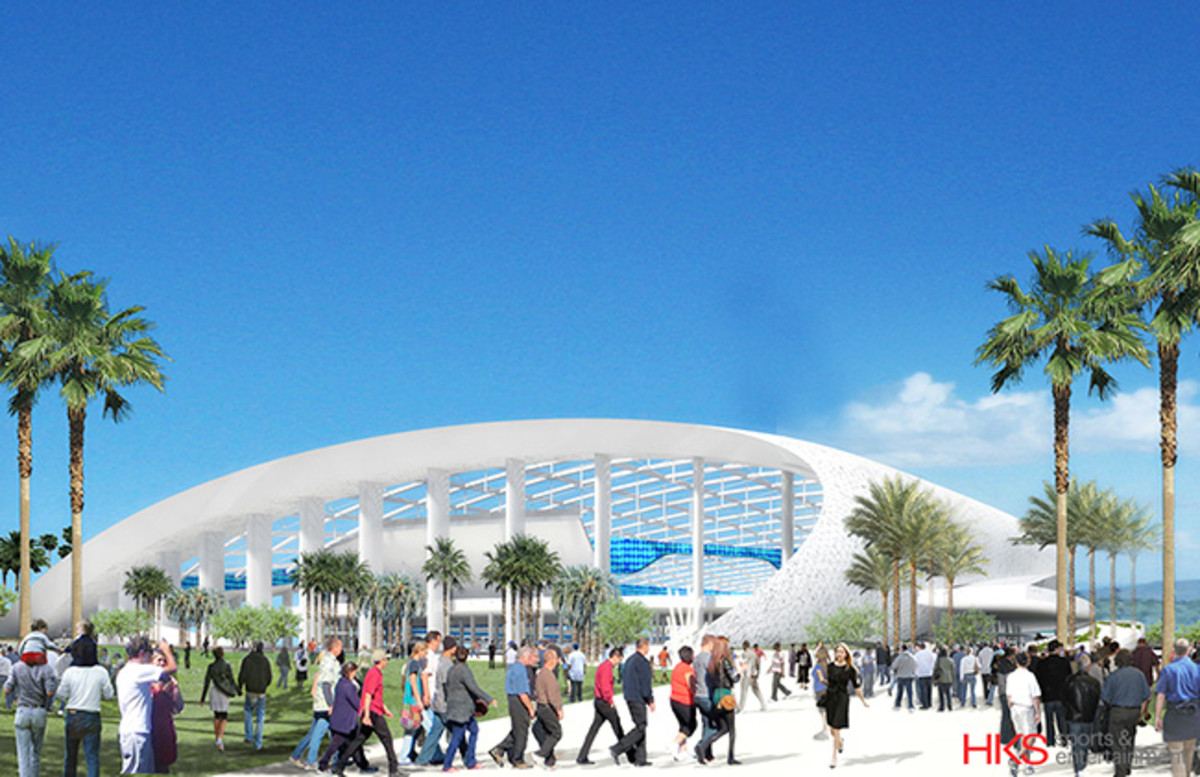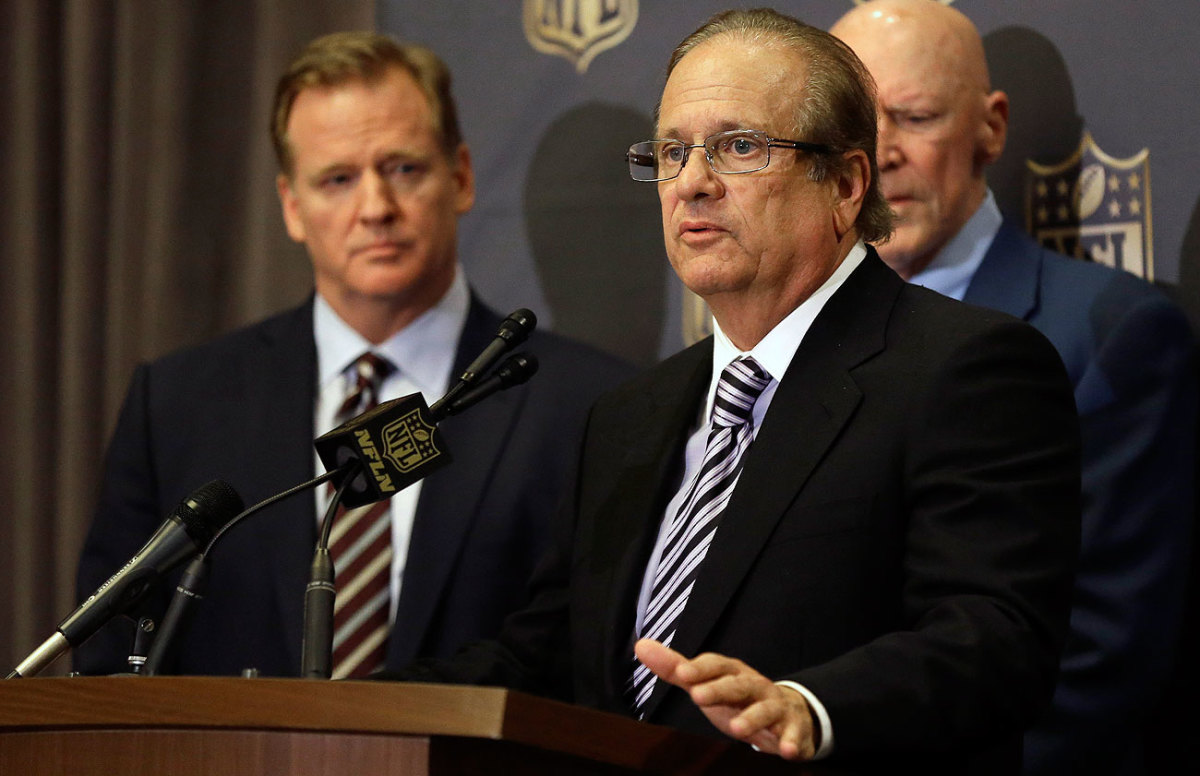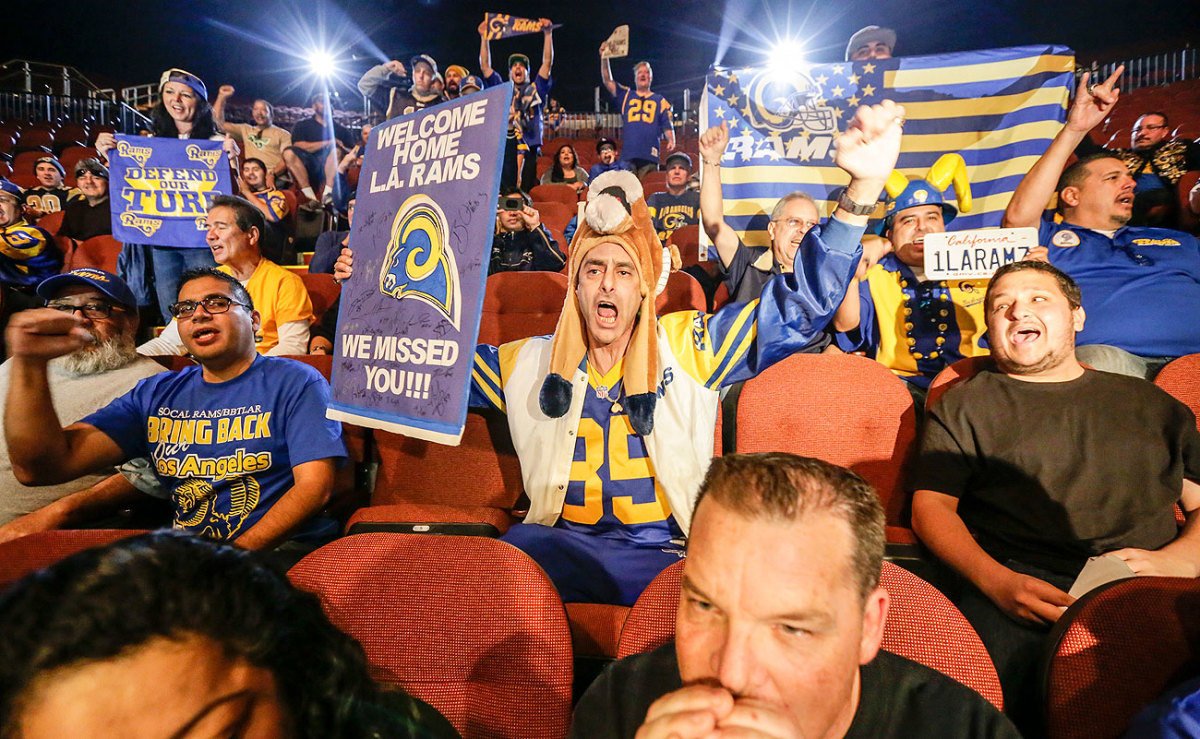The Six Hours That Will Shape the NFL’s Second Century

It’s been a week since the NFL’s biggest postseason upset happened inside a Houston hotel: NFL owners voted to approve the move of the Rams from St. Louis to Los Angeles immediately, while giving the Chargers a one-year option to join the Rams or get a stadium deal done in San Diego.
But the strangest aspect of that vote is still being debated in some league circles: Six hours after an influential league committee handling the Los Angeles negotiations voted 5-1 to recommend to ownership that the league allow the Chargers and Raiders to move to a site in suburban Carson, the owners rebuked their own committee and voted 30-2 to let the Rams and owner Stan Kroenke to move to Inglewood, scuttling the Carson site forever and ruining the hopes of two teams looking to Carson for long-term franchise salvation.
Those are the six hours that changed the current course of NFL history. What happened, exactly? How did so many owners who professed their love for San Diego chairman Dean Spanos turn on him—and the committee of heretofore trusted veteran owners—in the matter of one Texas afternoon?
Three answers:
1. A secret ballot, so owners who favored the Inglewood project could turn their backs on Spanos without him being sure who they were.
2. Kroenke’s jillions.
3. History repeating itself, with a rebuke of a powerful owner conjuring memories of another powerful owner slapped down a quarter-century ago by a new guard with different ideals.
This is not quite a tale fit for the Coen Brothers and the big screen, but if you like stories detailing the reasons why rich people make the decisions they make, it’s a fun ride.
* * *

At 1:30 p.m. on Jan. 12, in the Azalea Ballroom at the Westin Houston-Memorial City, the 32 owners (or owners’ proxies) returned from lunch to hear from the six-man Committee on Los Angeles Opportunities. One of the key members, Carolina owner Jerry Richardson, had already come out strong for Spanos and the Carson project, so it was no real surprise when the full body heard the results: five votes for the Chargers and Raiders to move to Carson, one vote for the Rams, and the Rams only, to move to Inglewood, closer to downtown L.A.
• THE MMQB ROUNDTABLE: Peter King and staff on the postseason and other top issues
There were murmurs in the room, but the committee vote shocked no one. Art Rooney II of the Steelers gave his reasons for the majority—solving the Charger/Raider stadium problems, fixing the California stadium conundrum, helping two tradition-rich California franchises—and Kansas City’s Clark Hunt spoke for the minority. He was the minority.
“I dissented,” Hunt told The MMQB, “because I felt the NFL would be best served by having less realignment. Moving one team would be less disruptive to our fan base. And, also, having just one team in Los Angeles would give the league the best chance to be successful.”
“Clark was artful,” said one person who was in the room. “But it was clear what he wanted and what he thought was best.”
Right. Hunt wanted just one team in Los Angeles. And that seems most logical. Though it’s become fashionable to say two teams is the best idea and will eventually both build strong fan bases, the NFL would be asking two teams to become instantly loved in a region that hasn’t had pro football for 21 years. It might happen. But it’s no lock. Hunt realized that. Privately, several owners applauded his bold stance, because they felt Richardson was trying to ramrod the Carson project through.
One point to make before moving on: During the morning meeting, when the final details of both projects were laid on the table for the owners, two owners not known for their loquacious leadership stood up to give ideas. Seattle’s Paul Allen, an E.F. Hutton type who rarely attends such meetings and more rarely speaks at them, said the owners needed to consider the project—that is, the proposal for the stadium and its additional amenities and opportunities—more than anything else. And Eagles owner Jeffrey Lurie spoke stridently for Kroenke. Those two men influenced the room, and quite possibly portended what was to happen in the afternoon.
“Carson never had the ‘wow’ factor,” one top club official said. “The Rams’ project did. Sentiment for that project became a tsunami.”
Once the membership heard the 5-1 vote, the next step was voting on the project, with a three-quarters majority (24 votes) being required for one side to win. Commissioner Roger Goodell, who proponents of both projects told The MMQBplayed each proposal down the middle, nonetheless was about to do something that he knew could tangibly affect the outcome. He’d been asked by “six to eight” owners, a source said, over the previous month about the feasibility of this vote being by secret ballot. “Roger knew we had a serious split in the membership,” the source said. “He knew neither side had the votes to win. But he also felt owners needed to vote their consciences, so proposing the secret ballot was something he felt he had to propose, and it was a no-brainer after several owners asked him to do it.”
Goodell proposed the secret ballot, and asked for a show of hands on the idea. A majority would rule. Asked how many favored a secret ballot, more than 17 raised their hands. (The Los Angeles Timesreported the vote was 19-13.)
Why was the secret ballot so significant? The Chargers/Raiders faction felt it had between 18 and 20 votes solid entering the meeting—something the Kroenke side believed was fiction. But there was something about the Rams/Inglewood project that, while inconvenient for those who wanted the Chargers and Raiders stadium issues fixed in one fell swoop, many owners knew was better for the NFL long-term: Instantly, the 298-acre Inglewood site would be the best NFL property in the league … with $2.7 billion worth of buildings and development, including a 70,240-seat stadium with translucent cover that would join the regular Super Bowl rotation; a campus for a so-called “NFL West,” including a new building for NFL Network and new home for NFL Media; and a 6,000-seat theater that one day one owner said “we hope will host the Oscars.” Carson was a nice project, but it couldn’t compete with all those bells and whistles.
Ballots were printed and distributed to the 32 owners/proxies in the room. A vote was taken. It has been widely reported that the first vote was 20-12 in favor of the Kroenke/Inglewood project, then 21-11 on the next one. But one source in the room said the vote was actually 21-11 the first time, then 20-12 the second time—inexplicably. Whatever the vote was, one owner said Dean Spanos “was utterly shocked—white as a sheet” at the first vote. And he realized that it would be nearly impossible to overturn the will of the silent but overwhelming majority.

In talking to three owners in the wake of the vote, it became apparent that they were convinced Kroenke’s project, the most ambitious stadium/development concept in American sports history (likely to end up costing more than $3 billion by the time it’s fully operational in 2019), was the best thing for the NFL’s second century. (The league’s 100th anniversary is in 2020.) To succeed in Los Angeles requires what one league source said was an “L.A. Live on steroids,” referring to the Staples Center complex where the Lakers and Kings play. In other words, NFL-big. Kroenke, with his fortune in the billions (net worth $7.4 billion, according to Forbes), had agreed to put $1 billion into the project—money the Chargers and Raiders owners just didn’t have.
But the vote wasn’t at 24, and there was some discussion about a potential compromise. Owners could vote for Carson. Owners could vote for Inglewood. Or owners could vote for Inglewood plus one other team, as Dallas owner Jerry Jones had suggested. Now Baltimore owner Steve Bisciotti said why not just combine B and C, Inglewood and the extra team. And because it was obvious the ownership felt Spanos and the Chargers deserved first shot, why not make “B” the Rams and Chargers in Inglewood? Bisciotti’s idea was embraced by the league.
So Goodell, trying to form a proposal that could get 24 votes, adjourned with the six-man L.A. committee. They were gone about an hour. During that meeting, each of the three owners looking to move rotated through to be apprised of the compromises the leagues and committee were considering. They threw around several ideas and settled on this one: Because it was clear that San Diego was the franchise favored over Oakland for relocation, the committee would propose giving the Chargers a one-year option to join the Rams in the Inglewood project; construction would start immediately regardless of whether a second team joined. Then, if the Chargers didn’t exercise their option to join within one year, the option would belong to the Raiders. In addition, the league would throw in $100 million if the Chargers or Raiders reached agreement in their existing markets to build a new stadium.
• THE NFL RETURNS TO L.A.: King on the aftermath of the Rams’ vote
Goodell and the committee returned to the room and explained the compromise. The membership knew Inglewood was going to pass muster; it was just a matter of time. And this proposal—which would potentially motivate the politicos in San Diego to take another shot at a stadium, with $100 million more from the league as a spur—seemed the fairest to both Spanos and the Rams. The Rams were willing to take a partner in Inglewood, but Kroenke would prefer to go it alone. But if it meant the league would give the project its blessing, it was a deal Kroenke was fine with.
The previous Friday, in New York, Kroenke had agreed to a revenue split if it turned out he eventually would take on a partner. All along, Spanos did not want to be Kroenke’s tenant—or anyone’s tenant, for that matter. But if Kroenke did a deal to take all the risk for potential cost overruns and other financial liability, and motivated a second team with a profitable stick-and-carrot, might that tempt the Chargers? In the end, on Friday, Kroenke agreed to let a second team keep all game-day revenue in and around the stadium on days it played. And he told the league he would agree to a formula that gave the second team 18.75 percent of other lucrative deals associated with the new stadium—such as signage and stadium naming rights. When the deal was relayed to owners on Tuesday, one owner exclaimed, “Sign me up! We’ll be the Los Angeles Wolverines!” (Writer's note: The team name is changed, because the owner told the story with the agreement that he not be identified.)
The vote was anticlimactic: 30-2. There was light applause. No owner wanted to show up Spanos. They were clapping, one said, for Kroenke, and for this long ordeal being over.
Kroenke rose. “Thank you for your trust,” he said. “I won’t disappoint you.”
* * *

A few things to know:
• St. Louis is the jilted party here, obviously, losing its team. But the lease signed by St. Louis officials to get the Rams to come in 1995 was such a team-favored arrangement that the only way it wasn’t going to end ugly for St. Louis was if the Rams’ owner—Georgia Frontiere first, then Kroenke after she died in 2008—agreed to rewrite the terms of the lease. Kroenke wouldn’t do that. Those terms said the locals had to keep the Edward Jones Dome a top-tier stadium, which in NFL parlance is taken to mean “top quartile,” or top eight. That would have meant St. Louis would have had to inject $700 million into the Edward Jones Dome by 2015 to keep up with the Joneses (Jerry, and other owners) throughout the league. St. Louis was never going to do that, and pledged about a quarter of that amount. Kroenke said no. Now, you can nail Kroenke for disingenuous negotiating, for never stridently pleading his case publicly and disappearing and never engaging with the fans or politicians to try to get a deal done. All fair criticisms. Nail him too for being a local guy who never seemed earnestly interested in the Rams staying in St. Louis. But to Kroenke, a deal’s a deal. He wasn’t going to let the locals break a binding lease.
Regarding the unexpected swing in votes, one longtime team and league official said, “I sense a shift in the geological plate of the NFL.”
• Jones, according to one top club official who got a call from him urging this team to vote for the Rams’ project, was a major salesman for Kroenke. “Jerry thought Jerry Richardson went overboard trying to push Carson,” the official said. In the end, Jones spent hours lobbying for Kroenke’s deal, and as another club official said, it had nothing to do with the relationship between Jones and Kroenke. They’re not particularly close. Jones just felt this deal had to be about the owner who had the deepest pockets and the most invested in making Los Angeles work.
• Said one top club official I trust: “Carson never had the ‘wow’ factor. The Rams’ project did. Sentiment for that project became a tsunami.”
• Maybe it won’t matter in the end, but I get no great sentiment favoring the Chargers to move to Los Angeles. If they win, that’ll change. But the Rams were in Los Angeles and Anaheim for 49 years, so there’s a natural sentiment to be loyal to them when they return. Spanos is likely loathe to remain in San Diego because of years failing to make a deal there, and it makes sense to move to a place that is going to take away every financial woe. But San Diego is such a loyal and vibrant market, and it’s the only place in southern California that loves the Chargers. Could the $100 million spur by the league be the impetus to get a deal done with the city on a new stadium? So many in the league hope so.
• Now for the allegory 25 years in the making …
Once upon a time in the NFL, the establishment told the new kids what was best for everyone, and the kids rebelled. This was in the early ’90s, when the league, in the midst of a multibillion-dollar network TV deal (four years, $3.6 billion), proposed to rebate its TV partners because they were taking a financial bath. Some new-guard owners, including Jerry Jones, nixed it. The new guard worked to get nine votes so they could block the give-back. And they found nine owners, and there was no give-back. Old-guard leader Art Modell, the Browns owner, chairman of the Broadcast Committee and the biggest advocate of relief for the networks, subsequently resigned his prestigious TV post.
In 2016, Richardson pushed hard for Carson, and thought he had a majority of owners supporting the Chargers/Raiders project. But when the secret ballot came, it was clear the majority was for the project, not for Spanos. “Classic case of Jerry [Richardson] misreading the field, of overplaying his hand,” one owner said. Richardson, essentially, became the Modell of 2016. He’s still a well-respected owner, but he’s not the power broker some thought when the Los Angeles process started.
A few days after the Rams got their deal, one longtime team and league official mulled the meaning of what just happened. He said: “I sense a shift in the geological plate of the NFL.” A few people were reaching for that conclusion in the wake of a Richie Rich owner getting his way, and the new breed celebrating the shiny new football palace set to open in America’s second-largest city in 2019.
I get it, but I’m not so sure. A shift toward the new breed is exactly what people said in the early ’90s, when the owners pushed out Modell and ushered in the new TV model (in favor of FOX using the NFL to build a prime-time network, which has worked).
The NFL isn’t changing so much. It already has changed.
Now for your email...
* * *
PACKERS SHOULD HAVE GONE FOR TWO
I'm probably the 900th person to ask you this, but should the Packers have gone for two after the Hail Mary? Instead of a longer extra point (with more risk this year) to tie it and leaving it to the fate of the overtime coin toss, the Packers could have entrusted their Hall of Fame quarterback to go for the win from two yards out against an obviously stunned Arizona defense with no timeout left to regroup. Your thoughts?
—Robert D., Nashville
I’ve heard a lot of people say that in the past 48 hours. While I am generally in favor of teams going for two instead of kicking the PAT, I am not a very big fan of doing it if the outcome of the game depends solely on whether even a very good quarterback like Rodgers can get the ball into the end zone from two yards out. Normally you would say, sure, I’ll take my chances with Rodgers from that distance. But if I’m Packers coach Mike McCarthy, and I have watched my defense play pretty well for four quarters, I’d probably take my chances knowing that even if I lose the coin flip, odds are in my favor that my offense will get at least one chance at the ball in overtime. Also, think of the outcry if Rodgers throws an incomplete pass on an attempted two-point conversion and the Packers lose 20-19. McCarthy would have been roasted from coast to coast, and probably rightfully so.
AMENDOLA’S HIT
It's really disappointing to see an entire section about a player who is hitting correctly, Reggie Nelson, yet there's not even a snippet about the cheap shot Danny Amendola put on Jamell Fleming. I know that it was flagged, but in college that would be targeting and an ejection, and that's what he deserved. There's no place for that, and your silence on the subject is surprising and I hope simply an oversight. Luckily Fleming wasn't seriously hurt and it didn't come at a critical juncture in the game, so it's not talked about in the same way as the Vontaze Burfict hit from a week ago, but it is still the kind of play that the NFL should be eliminating. At a bare minimum, the rules regarding “defenseless” should be amended to include all players regardless of their offensive/defensive standing.
—Matt, Overland Park, Kan.
I’d like to see the competition committee take a look at this play. To review, Fleming was camped under a punt, basically like a punt returner, trying to down it inside the New England 5-yard line. He was completely defenseless, and Amendola creamed him. It was unclear to me whether Amendola hit him in the head/neck area or a little lower. Regardless, expect the competition committee to address these types of plays that leave a player completely defenseless.
SARAH THOMAS, THE BEST NON-STORY
Can we pay homage to the greatest non-story of this season? Sarah Thomas, in her first season as an NFL official, made her historic mark with no controversy, no headlines and no ammunition for the talking heads to pontificate over. Congratulations, Sarah. You were the ultimate pro.
— Doug, Michigan
Thanks for the reminder. Former Raiders executive Amy Trask wrote a column for us when Thomas was named the NFL’s first full-time official, and that was her point. It would be progress, Trask wrote, if Thomas got treated exactly like her male counterparts—criticized when she was wrong and credited when she was right. That’s about how this season went for her.
THE NEXT GREAT RIVALRY
Wanted to know your thoughts; as the Brady-Manning rivalry nears an end, does this mean that Cam Newton and Russell Wilson will be the next great rivalry? If not, who?
—Dallas S., New York City
I sure hope it will be Newton-Wilson. That will be a treat for everybody who watches the NFL. Fifteen years after Brady-Manning was born, Newton-Wilson would be fresh and fun because both guys can play from the pocket and play from outside of it. I hope you’re right.
NO MORE COIN TOSS
I'm not a fan of how the overtime coin toss inherently gives one team an advantage. I figure, why not just remove the overtime coin toss from the game? Have the receiving team in overtime determined by something else. Maybe the team that finishes with the ball in regulation receives it (although this would probably cause people to play for overtime in regulation). Or have the team that chooses to receive in the first half also receive in overtime if the game gets there. Robert Mays' article last week said most teams were choosing to defer, so this might create some interesting strategic decisions.
—Thomas B., Houston
I have long favored both teams being guaranteed an overtime possession. It is an advantage to have the ball first, plain and simple. It is an improvement on the rule to mandate that the team getting the ball first has to score a touchdown for the game to be over immediately. But it is only a partial fix of a broken system. I understand everyone who says, “Play defense,” and the league has bigger problems, both on and off the field, than addressing the substance of overtime again. But I simply believe that the fairest way to do it is to make sure that each team gets the ball once in overtime.
• Question or comment? Email us at talkback@themmqb.com.
